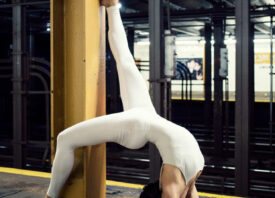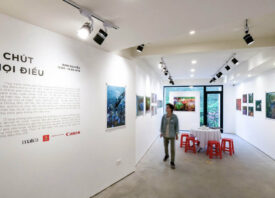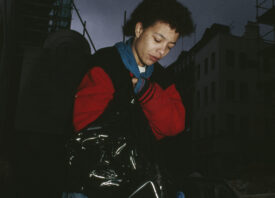Search this site
New Photo Book Celebrates the Traveller Subculture

Feature Shoot first profiled “lost & found” back in 2017. The project completely captivated me back then, and seven years later, it still resonates strongly. Photographer Michael Joseph says, “Travellers are some of the most intelligent, kind people I have met who are raw and open. I think anyone can learn a lot from how they live and their experiences.”
After spending over a decade working on this project, Jospeh has now published this work as a photo book with German publisher Kehrer Verlag.

You’ve been working on this series for over a decade. Why is now a good time for a photo book?
“After a decade of photographing this subculture, I lived through the arc of those who left home and were new to the road, to the height of their travels, and then watched some pass away and others settle down from a life on the road. Initially, I wasn’t documenting stories, but as time passed, I saw the importance of recording stories, both written and audio. More and more travelers passed away. I lived through some travelers changing both physically and mentally.
“Some lost their initial drive and excitement for the road. Others knew they had no home to return to so their life is the road. I saw these Travelers as the most modern version of historic American wanderers and freedom-seekers. From the 1930s Dustbowl Era hobo to the 1950’s Kerouac inspired Beatnik, to the 1970s Haight-Ashbury Hippie to the 1990s East Village Punk Squatter. I wanted to create a document, both written and visual, to solidify this subculture in American history.
“I wanted this document to live in the physical world, not just small online pictures on a phone. I wanted to produce something substantial, with great quality printing, paper, and size, to present the subject with dignity and justice. I wanted to send friends and families a copy of those they love, loved, and lost. Most importantly, I wanted the general population to be able to read the stories of this mostly misunderstood subculture. I feel like they are passed by and looked at with disgust. Travelers are some of the most intelligent, kind people I have met who are raw and open. I think anyone can learn a lot from how they live and their experiences.”

Can you talk about the events that led you to photograph travelers initially?
“In 2011, I was visiting Las Vegas and was in a taxi on my way to see an attraction. From the window, I saw a man standing on the side of the road with a sign that said, “Arizona of South.”
“He had striking features; His hair was a faded blonde. His eyes were striking blue. His face was red and sunburned. He had an identifying anchor tattoo that swirled around his cheek. I asked the driver to stop and let me out. I introduced myself with a handshake, and he agreed to let me photograph him. I hailed another taxi and was on my way. At the time, I didn’t think much of our interaction. I didn’t write down his name or ask his story. This was a mistake that left me searching for years to come.
“At the time, I was working on a collection of street portraits of strangers. I wanted to meet people I might not otherwise get to meet day-to-day. I wanted to afford the viewer the same interaction by making close portraits. After I met my first Traveler in Las Vegas, I began photographing them on streets all over the country. New Orleans, Austin, Cambridge, and New York City became the most productive places to make portraits. In the process, I learned that the man’s name was “Knuckles,” and he was well-known among other Travelers.
“Every time I went out to shoot, picking up clues about the subculture as I continued to document it, Knuckles was in the back of my mind. Three years after making that first portrait of him in Vegas, I was in Chicago riding the elevated subway or “L” to the airport. The train stopped, and passengers were forced to exit and board a bus for the rest of the trip. Beside the steps, at the base of the exit of the Damon stop, out of the corner of my eye, I spotted a man with an anchor tattoo on his cheek. I was stunned. Was this possible?
“I approached him and asked if his name was Knuckles. I showed him the portrait we made together. It was him. He jumped up and hugged me. We took a quick picture together. We exchanged information, and, in a rush, I was on my way.
“Three months later, I was shooting in New York City and spotted two Travelers walking through Times Square. I introduced myself and asked if they knew Knuckles. They told me he was in Union Square. I immediately jumped on a subway line to find him. Knuckles and I spent the weekend together. He was kind enough to introduce me to his traveling crew. That weekend was mostly about listening, but I also made some portraits. I became so interested in the Travelers not only as a subculture to document and photograph but also as intense people with incredible stories.”

What are some of your most memorable experiences with this project?
“One of the most unbelievable memories was walking off the elevated subway “El” in Chicago to find Knuckles, the original traveler I photographed three years later. I had been searching for him but was unable to find him. Serendipitously we reconnected and then three months later again in New York City. It felt like there were forces beyond me that led us back together.
“Another memory was opening my mailbox in Boston to find a package that a Traveler’s mother had sent me. I photographed this traveler multiple times over the years and kept in touch as he was on and off the road. Sadly, he passed from an overdose. His mother knew that I would be traveling down to New Orleans, and so sent me a package of some of his ashes. She wanted to have me bring them to a memorial in New Orleans. When I arrived, other people had similar envelopes. Some ashes were distributed into charms that travelers wore around their necks, allowing him to continue his travels through others. Some were put into bottles of alcohol and ingested. The rest were sprinkled into the Mississippi River.
“One of the most memorable shooting experiences was shooting in Cheyenne, Wyoming. There is a very large Union Pacific railroad yard there. I met up with a Traveler who drove across the state to meet me (I was driving up from Denver). We walked around the trainyard and then went to a specific bar where many Travelers would meet up. Near that bar was a specific underpass that so many Travelers inscribed with graffiti and tags. I saw so many tags from those I photographed in the past. Some were from travelers who passed away. A Traveler was hanging out there, and I made a few portraits of him.”


What has this project taught you about life?
Travelers opened me up to a way of thinking and forced me to question the way I was living my life. Some of these are: How much do we really need to be happy? How much do we need to live and survive? What is better, a short life filled with vast experiences or a long one that is sedentary and unexamined?
I have a sense of exploration and curiosity that the Travelers have. For me, it is about people. I’m interested in their wishes, motivations, backgrounds, struggles, and truths. In this way, I suspect that we share the trait of wanderlust.
The book’s opening states, “I have everything and nothing and everything at the same time.” They taught me that we really don’t need much to find happiness. They also have these intense, raw relationships forged by helping each other find their way and survive. These intense relationships and acceptance into a tight community exemplify how our life happiness is directly related to those relationships we make and those live, in-person experiences we share with others. The traveling experience makes their lives full.

Where did you photograph most of the travelers? I’m assuming you did not go on the road with them, but have you ever been tempted to try this lifestyle?
The most productive locations proved to be New Orleans, Austin, New York City, San Francisco, and Cambridge (as they passed through Boston, my hometown). I did not go on the road with them as I didn’t see it as my place. Not only is it dangerous, but it is also illegal. I promised “G”, one of the travelers that I became very close to, that when I was done with the project, I would take a short ride with him so I could see all those beautiful sunsets, feel the movement of the train and experience all the best parts of riding trains that he bragged about. Sadly, he passed away before I’d get the chance.

“lost & found” is available online, in physical bookstores, and through Kehrer Verlag.



